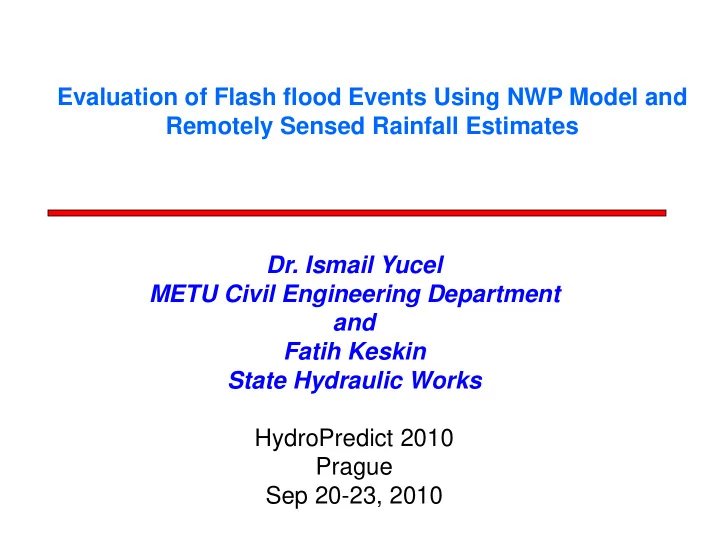

Evaluation of Flash flood Events Using NWP Model and Remotely Sensed Rainfall Estimates Dr. Ismail Yucel METU Civil Engineering Department and Fatih Keskin State Hydraulic Works HydroPredict 2010 Prague Sep 20-23, 2010
Outline • Introduction • Data & Methodology -Satellite, Radar, Station and NWP rain • Hydrologic Modeling • Conclusion
Water and energy cycle • Warming climate leads to heavy precipitation events. • This tends to increase the risk of flood events.
Annual Rainfall Distribution of Turkey 2500 mm 250 mm
LONG-TERM OCCURRENCE DISTRIBUTION OF METEOROLOGICAL HAZARDS IN TURKEY ( 1940 - 2002 ) FOG 1% AVALANCHE THUNDERSTORM 0% TORNEDO MUDFLOW 2% FROST HAIL 0% 0% 9% 23% HEAVY SNOW 8% FLOOD STORM/HEAVY WIND 30% 27% Flood hazards represented 30 % of all water related disasters in Turkey. 1,344 people died due to 1,768 floods in last 50 years in Turkey. Economic damage is more than USD 3,000 million during this period. 255,640 ha agricultural area was effected.
MAJOR FLOODS AND LOSSES DATE AREA AFFECTED LOSS EVENT ECONOMIC LOSS DEATHS 9-15 May 1993 Eastern and Southeastern Parts Heavy rain Hundreds of houses damaged. 5 Major losses to agriculture 1-2 Dec. 1994 SE, Adana Heavy rain Hundreds of houses damaged. Major losses to agriculture 1-5 May 1995 E, Bitlis Heavy rain $23,000,000.00 Istanbul, Senirkent, Ankara, 8-14 July 1995 Heavy rain, landslides $ 30,000,000.00 70 Trabzon 3-5 Nov. 1995 Izmir, Isparta, Antalya Floods $ 50,000,000.00 61 6 Feb. 1996 Izmir, Antalya, Canakkale Heavy rain 1,000 houses damaged 5 9 Aug. 1996 Istanbul Heavy rain $ 4,000,000.00 11-13 Aug. 1997 Istanbul, Zonguldak, Bursa, Heavy rain, landslides $ 1,000,000.00 13 Bolu 6-22 May 1998 North, Southeast, South and Heavy rain, large hail, $ 2,000,000,000.00 27 Anatolia landslides, mudslides 12 June 1998 Sanliurfa, Diyarbakir Heavy rain Roads flooded, bridge 8 destroyed 9-13 Aug. 1998 Trabzon Torrential rain, landslides 300 building, 1 mosque 10 destroyed 27 May 2000 Samsun, Tokat, Carsamba, Heavy rain Hundreds of houses flooded, 2 Salipazari, roads, bridges damaged. 7-18 May 2001 Hatay, Osmaniye, Konya, Rainstorm, torrential rain $ 3,500,000.00 3 Nevşehir 10-12 May 2001 Antalya Heavy rain 500 homes flooded, 37 buildings damaged, 4 bridges collapsed 10-14 Nov. 2001 Rize, Artvin Heavy rain, mudslides Buildings, roads, highways, 8 bridges damaged Mersin, Izmir, Istanbul, Heavy rain, blizzards, high Dec. 2001 $ 30,000,000.00 5 Ankara, Icel, Yalova wind speeds 23-25 July 2002 Rize, Corum, Yozgat, Kars, Torrential rain, high wind $ 20,000,000.00 40 Tokat, Van speeds, mudslides
• Investigation of heavy rainfall events occurred during Sep 7-12 2009. • Rainfall occured 10 times gerater than September average value (25 mm) during these days. • Station, satellite, radar, and NWP model rainfall data are used.
NOAA’s Satellite Rainfall Algorithm: Hydro Estimator (HE) 3.5 Area-averaged raınfall (mm) 3 2.5 2 1.5 1 0.5 0 1 5 9 3 7 1 1 5 9 3 7 1 1 5 9 3 7 1 1 1 2 1 1 2 1 1 2 Hour HE Ortalama İstasyon Ortalama
Sep 8, 2009 (Radar) Sep 8, 2009 (gauge) Sep 8, 2009 (HE) Sep 9, 2009 (gauge) Sep 9, 2009 (Radar) Sep 9, 2009 (HE)
Event totals for 7-9 Sep, 2009 Rain gauge Satellite Algorithm
Weather Research and Forecasting (WRF) model Simulations: 12-km and 4-km WRF domain setups 3-D Var data asimilation
WRF with and without 3D-Var Simulations for Sep 8,9,10,11, and 12, 2009
Hourly Event Totals Daily
Satellite rain (Sep 8, 2009) Gauge rain (Sep 8, 2009)
Ayamama Basin Characteristics: 1/5000 scaled Topographic Land use Soil type map is used in the study.
Ayamama Basin Characteristics: Sub-basins Sope Topography Mean Mean Accumulation Longest Basin Area slope Elevation Time Channel Length 71,02 km 2 6.94 % 86,64 meter 7.11 hour 41,314 km
HEC-HMM Hydrological Modeling [m^3/s] [mm/h] Ayamama Deresi Modelleme 260.0 Mean radar rain 18.0 240.0 Mean gauge 16.0 220.0 Runoff (WRF) rain 200.0 Runoff (gauge) 14.0 Runoff 180.0 12.0 Runoff (HE) (radar) 160.0 Yagis Debi 140.0 10.0 120.0 8.0 100.0 6.0 80.0 60.0 4.0 40.0 2.0 20.0 0.0 0.0 00:00:00 00:00:00 00:00:00 00:00:00 00:00:00 00:00:00 00:00:00 7-9-2009 8-9-2009 9-9-2009 10-9-2009 11-9-2009 12-9-2009 13-9-2009 HE Radar Station WRF_NA WRF_A 300 250 200 150 100 50 0 September 5 September 6 September 7 September 8 September 9 September 10 September 11 September 12
Water coverage calculations along with river path for determining flooded areas Ayamama Creek Plan: Plan 01 15.09.2010 Input is prepared in ArcGIS Imported in HEC-RAS and run 15937.10 with help of HEC-GeoRAS module in steady state mode 15387.10 15062.10 14762.10 14362.10 14062.10 13737.10 13337.10 Ayamama_Main A 12987.10 am a y ma 12612.10 12312.10 15937.10 11812.10 15487.10 11512.10 15087.10 11162.10 14737.10 10887.10 14312.10 10587.10 13962.10 10287.10 13562.10 9962.107 13187.10 9662.107 9337.107 12762.10 8937.107 12387.10 8562.107 12012.10 8212.107 11512.10 7962.106 11112.10 7687.106 10637.10 7412.106 10287.10 7137.106 9912.107 6312.106 9562.107 4575.827 6012.106 9162.107 5709.065 4175.827 8787.107 5385.921 3775.827 8408.316 A ya 4987.106 3425.827 Ayamama_1 7937.106 4662.106 3050.827 mam 7587.106 2725.827 4196.927 7212.106 2375.827 3875.452 a_1 6312.106 3528.358 2000.827 5762.106 3165.309 1675.827 4887.106 1325.827 2843.568 4196.927 975.8277 2410.938 3666.750 631.4237 2060.938 1735.938 2843.568 1310.938 1785.938 1010.938 1310.938 760.9385 860.9385 510.9385 410.9385 260.9385
Radar Satellite (HE) HEC-RAS Ras Mapper Results: Station
WRF-No assimilation WRF with assimilation
Comparison between HE and Radar
Summary and Conclusions • The performance of the HE together with the radar, rain gauge and NWP model data is investigated to monitor and quantify the precipitation events for accuracy assesment and hydrological model application. • Satellite rainfall estimates potentially improve spatial prediction of precipitation in data poor areas. • HE underestimates the precipitation, but its frequency cycle matches well with observations. • The data poor areas can be filled by the radar data but the radar data should be used after full calibration process and error elimination. • Different precipitation inputs resulted in different storm hydrographs. • Based on the records, the realistic hydrograph is obtained from radar precipitation data. • Some differences in the coverage of the flooded areas are obtained in Ayamama basin after using peak values of the storm hydrographs in HEC-RAS program.
Recommend
More recommend